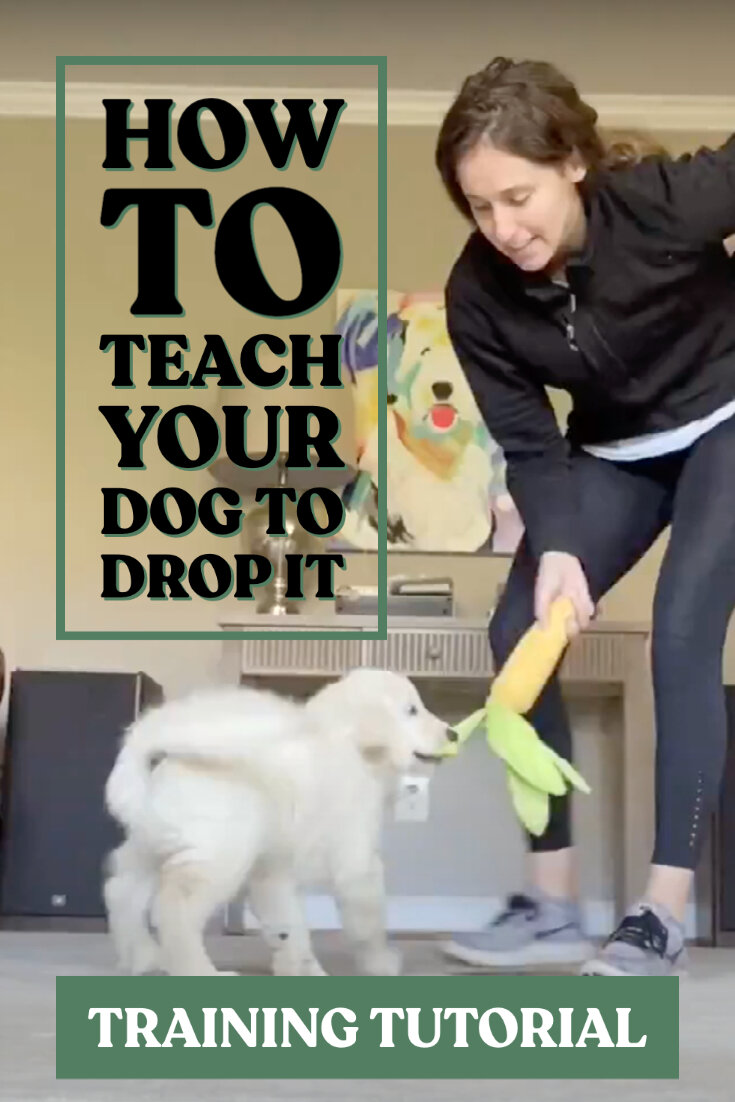Training Tutorial: How to Teach Your Dog to Drop It
When you visualize "drop it,” do you picture your dog letting go of something? What would happen if we started teaching drop it so that our dogs (at first) think it means something awesome is going to be given to them!? We learned this method from Chirag Patel, and it is our absolute favorite (for puppies and dogs). Keep scrolling for our step by step breakdown of how to teach your dog to drop it (which leads to a great enthusiastic drop behavior):
Step by Step: How to Teach Your Dog to Drop It
Step One: "Condition your drop cue" by saying your cue and then scattering treats on the ground (wave your hand in the treats for a second when you do this to draw their attention there and continue to make your hands near food a good thing). This may feel silly because your dog won't have anything in their mouth to drop! But remember, we just want them to think that "something awesome is coming" when they hear "drop," so we are making it predict food. Think about it - what do they have to do in order to eat food? OPEN THEIR MOUTH! Ta-da -- that is the foundation for drop! (Tip: Make sure you say “drop” before you show or reach for the treats. “Drop” must predict incoming treats, so they need to be two separate events.)
Step Two: Once you are seeing anticipation in your dog's body after saying the drop cue, start adding in some objects for them to actually bite onto. Start with more neutral objects and work up to higher value objects. At first, you may still have to almost immediately scatter those treats on the ground after saying your drop cue.
Step Three: Start to build a pause in after you say your drop cue to see if they drop the object on their own (because if they think great food is coming, they have to open their mouth to eat it ... so you will get an out if the cue is conditioned enough). If they do drop the object on their own after they hear the cue, mark the behavior (say "yes" or click) and then scatter treats on the ground! If they don't drop it right away, no problem - just scatter the treats without marking.
Step Four: Keep working through various objects (building in that pause) until you very consistently get an out behavior as soon as you cue it and are then able to mark and reinforce it with treat scatters (or whatever you choose). When you are ready, practice in new settings (try outdoors if you have been working on this indoors the whole time).
Why Reinforcing Drop It Pays Off Over Time
I also reinforce this drop behavior almost every single time. Because of how we teach it, dogs will drop things FAST even without a reward, but I want to keep "money in the bank" on this behavior since the city has a strange supply of chicken wings on the sidewalks. However, my reinforcement certainly changes over time as my dog gets good at this (aka I am not doing treat scatters forever, but hey, you totally could!). Here are some of the things I now use to reinforce a drop: my dog drops a chicken wing and I reward by finding a stick from the ground to toss or play tug with; my dog drops another dog's ball at the field and I reinforce that by tossing my ball to them; my dog drops a stick they carried outside before we go inside and I reward by running away and letting him chase me (and with lots of praise and scratches when they arrive). To be honest, I have even rewarded some harder "real life" drops indoors with "let's go get a treat" and I walk over to the cabinet with my dog to give them one (sometimes I am just not feeling inspired and this is easy). I still use treats plenty because they are fast and efficient! But I am offering the other examples because some people get hung up on not wanting to use treats for some reason. I can get away with just using praise and pets because I have built those up as good rewards over time, but I try to find some way to make the reward even higher value if I can since this behavior can be life-saving.
Pro Tip: Your Voice Matters When Training a Dog to Drop
Fun fact: I try to keep "drop" incredibly positive and happy. I actually teach it to dogs in a higher pitch because I can't angrily say "drop" in that tone (setting myself up for success!). If you are someone who is likely going to panic and scream this at your dog, you can actually condition your dog to that tone, so it is positive instead of scary. We don't want our dogs to think this is a scary or threatening cue. Because if dogs feel threatened or scared, you are more likely to get a dog who does the exact opposite thing you want and actually runs away with the object (and since this is a behavior that can save their life - we definitely don't want to accidentally teach that).
PS: Pin this article for later!




